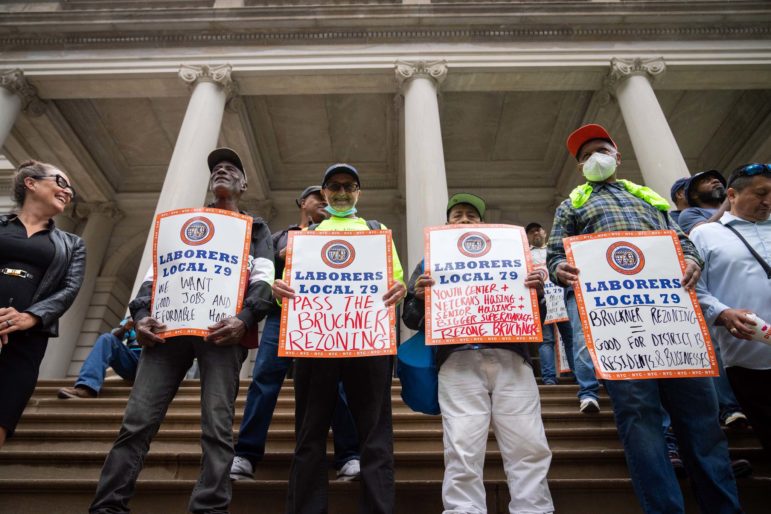
Labor is Latest Sticking Point in Debate Over Bruckner Rezoning
The New York District Council of Carpenters issued a statement opposing the plan, saying they would not receive enough work on 349-unit project proposed for The Bronx. Their stance was counter to several other influential labor leaders who have spoken in favor of the project for the jobs and new housing it will create.

Ed Reed/Mayoral Photography Office.
Adams administration officials joined some labor unions and community groups at City Hall Wednesday in support of the Bruckner Boulevard project.

A proposal to build a 349-unit apartment complex overlooking the Bruckner Expressway in Throggs Neck encountered a new potential political obstacle Wednesday when criticism from a local labor union added to a chorus of “Not In My Backyard” opposition from vocal residents and a key local councilmember.
The planned development depends on a residential upzoning approved by the City Council, which traditionally defers to the local member on land use issues in their district. In this case, that member, Marjorie Velázquez, has continued to oppose the project—siding with Bronx Community Board 10 and neighbors who have slammed a plan to add rental apartments, about half of them income-restricted, inside moderately tall buildings along the edge of their low-rise neighborhood.
Velázquez outlined her skepticism during opening remarks at a public hearing before the Council’s Subcommittee on Franchises and Zoning, citing concerns over the strain on infrastructure and the potential use of non-union labor.
“For a proposal to garner my approval, it must be centered on improving the lives and well being of my neighbors,” she said. “And it must be done by and for my community with union labor and provide affordable housing for those in my community who need it.”
She asked for specifics in writing about how the developers—a collection of property owners organized as Throggs Neck Associates LLC—will incorporate union labor. A few hours later, the New York District Council of Carpenters issued a statement opposing the plan because they said they would not receive enough work on the buildings.
“We urge all council members to follow Councilwoman Velázquez’s lead and vote no on the Bruckner Rezoning unless all projects are built with union labor,” said Joseph Geiger, the union’s executive secretary and treasurer.
But the statement ran counter to the stance of several other influential labor leaders who have continued to speak out in favor of the project because of the jobs it will provide and the new housing it will create. The president of 32BJ, Kyle Bragg, joined Mayor Eric Adams and members of his administration at a rally backing the plan Wednesday, shortly before the subcommittee hearing began.
Members and leaders of 32BJ and Local Laborers 79, which have agreements in place with the development team behind the plan, also rallied in support of it at one of the proposed project sites—a SuperFoodtown grocery store—last month.
“As a Bronx resident and an officer with 32BJ, I see the impacts of our city’s affordable housing crisis in my borough and at work every day,” said 32BJ Vice President Shirley Aldebol. “This rezoning is a perfect example of how we can tackle these problems at once and create better opportunities for working-class New Yorkers to thrive in this amazing city and neighborhoods like my very own Throggs Neck.”
Few new units of housing have gone up in Throggs Neck and the rest of Council District 13 over the past decade, with the district producing just 58 apartments with rents capped for low- and middle-income residents during Mayor Bill de Blasio’s tenure. The Bruckner plan would add nearly three times that amount.
The four proposed buildings—two eight stories tall, one five and another three—would include a combined 168 income-restricted apartments, including 99 units created through the city’s Mandatory Inclusionary Housing (MIH) rules.
All told, 99 units would be reserved for seniors, with another 22 set aside for veterans through a program operated by the Tunnels to Towers Foundation. Monthly rents in the income-restricted apartments would be priced to equal about a third of the income for people earning an average of 80 percent of Area Median Income—about $96,000 for a family of three.
Adams, who received the backing of the carpenters union during his 2021 mayoral campaign, has gone to bat for the project amid the pushback. Ahead of the Council hearing, he called out what he said was the true source of opposition: a “not on my block, not in my neighborhood” attitude among residents who do not want low-income renters moving in.
“This is a city where all income brackets deserve to have the appropriate housing that they’re looking for,” Adams said. “This project is just right, it’s the right project for the right time. And if you start placing barriers around communities stating that you can’t live here or build here, that is an unacceptable place.”
Indeed, some project opponents have explicitly framed the project as a magnet for poor renters in a neighborhood of homeowners with one- and two-family properties. “You’re property will go down if more low income/section 8 buildings are going to be built!” wrote one person on an online petition opposing the rezoning.
“These buildings are not a good idea for this area,” said another. “It is going to bring more crime and drugs to this area which has already been increasing. It is also going to further destroy the look of this Neighborhood.”
Other opponents, including members of Community Board 10, say they would welcome affordable housing but want to preserve the lower density character of the neighborhood codified in a 2004 downzoning.
“The community is not opposed to development or investment. We are not opposed to affordable housing, senior living or veteran’s housing,” said Community Board 10 Chair Joseph Russoin in Council testimony. “But develop and invest within the structure of the zoning.”
But the zoning puts major limitations on what is possible, said Jaclyn Scarinci, a land use lawyer for the development team. The lack of flexibility from opponents has also made further negotiations impossible, she said.
“In terms of density, it’s very hard for us to respond to a concern that they want you to keep everything the way that it is,” she said.
The post Labor is Latest Sticking Point in Debate Over Bruckner Rezoning appeared first on City Limits.


